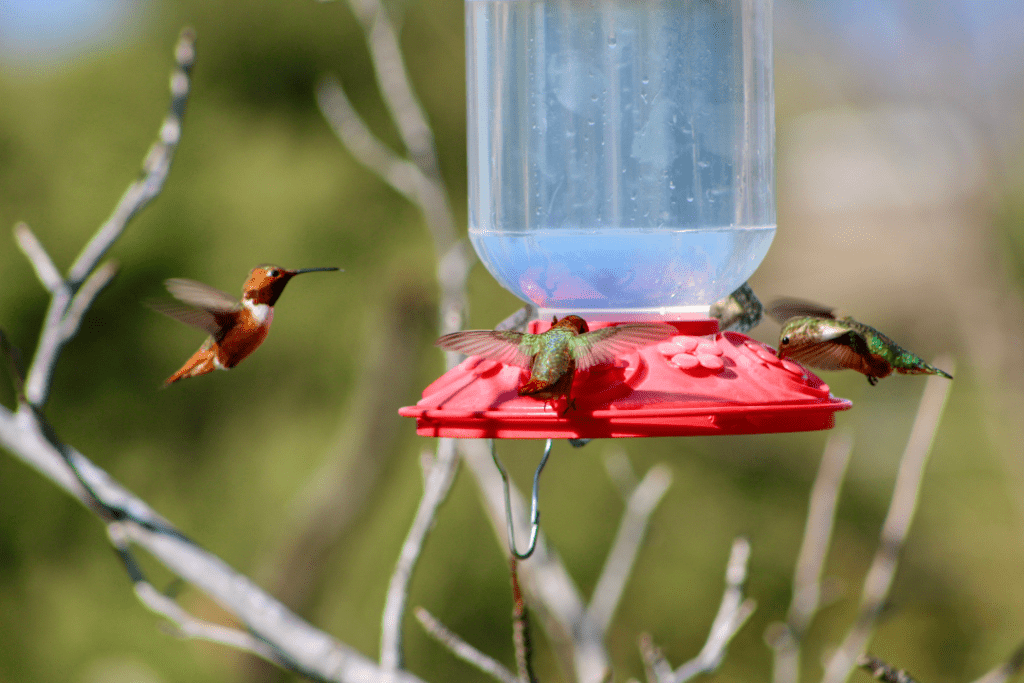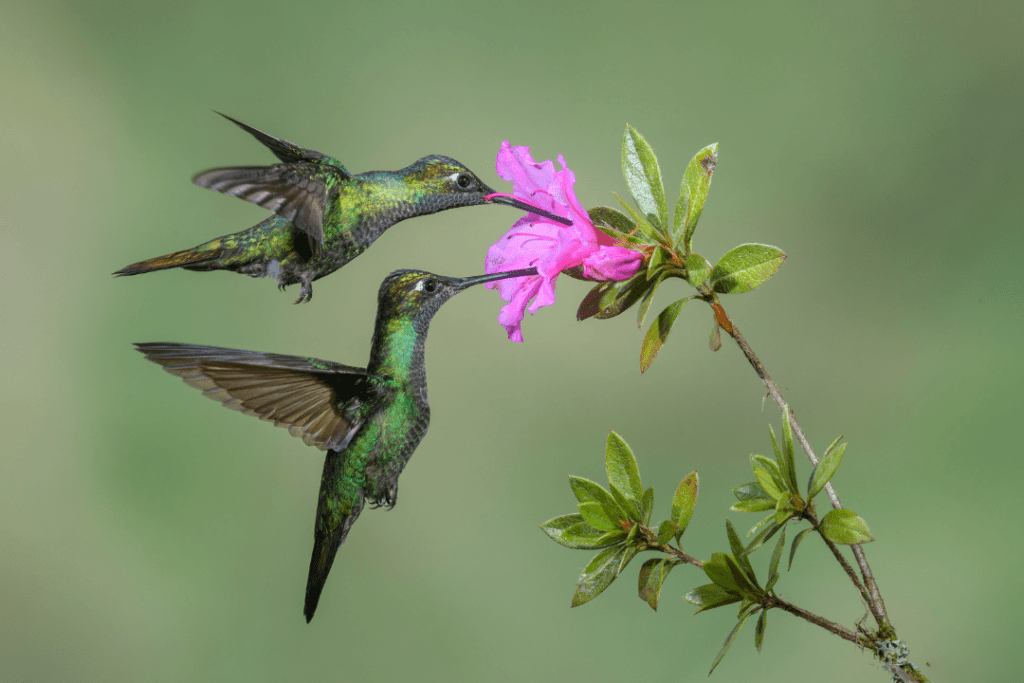For many birders and gardeners, hummingbirds are prized visitors. Their brilliant colors, incredible movements, and petite bodies inspire adoration and fascination.
Hummingbirds are most likely to spend time in a yard that’s full of life. The presence of hummers is a good sign that you’re managing a vibrant, colorful, wildlife-friendly property.

If you’re operating a hummingbird feeder, it’s important to keep it clean and full.
These tiny birds have huge appetites. To keep pace, you might end up making hummingbird nectar in bulk. If so, you’ll need to know how long hummingbird food lasts before it goes bad.
Let’s cover everything you need to know about serving and storing hummingbird food, including:
- What food can you give to hummingbirds?
- How to store hummingbird food
- How long does hummingbird food stay fresh?
- How can you tell if hummingbird food has gone bad?
What Food Can You Give to Hummingbirds?

Hummingbirds won’t visit a typical birdfeeder. Their little bills can’t crack seeds and their super-fast metabolisms are designed for foods that can be more quickly digested.
The hummingbird diet consists primarily of:
- Insects for protein and minerals
- Flower nectar for rapidly-available energy
Hummingbirds may occasionally drink juice from soft, overripe fruits, but flower nectar is a more easily-consumed form of liquid energy.
Nectar is high in calories and full of sugars.
To mimic the nectar found in flowers, hummingbird feeders are filled with a sugar water solution known as hummingbird food or hummingbird nectar.
Like bees, hummers show a preference for flowers that offer nectar with optimal sugar content. To make your feeder worth visiting over and over again, you’ll need a brew with the perfect amount of sweetness.
Here’s the tried and true nectar recipe that gives hummers just what they’re looking for:
- 1 part refined white sugar (no brown sugar, honey, non-sugar sweeteners, etc)
- 4 parts water
To prepare nectar, simply stir in the sugar until it’s dissolved.
It’s not necessary to use boiling water or to heat the mixture. However, if you’re making a large amount that you plan to keep in storage, boiling water for purification is a good idea. Just remember to measure your water after boiling, since boiling reduces water volume.
Keep in mind that the nectar we provide is just an energy supplement, not a primary food source. There’s no need to use a commercial mix with added vitamins or minerals.
Likewise, adding red dye is unnecessary and can be harmful. Stick to the simple two-part recipe. Hummingbirds are attracted to the color red. However, nearly all hummingbird feeders are painted red, negating the need for red nectar.
For more dos and don’ts on mixing hummingbird nectar and setting up your feeder, check out this guide on making hummingbird food without boiling.
How to Store Hummingbird Food
Rather than brewing a fresh batch every time you want to fill your feeder, you can make extra hummingbird food and store it in the fridge.
Use a sealed container with the lid screwed on tight. Before putting your nectar away, mark the date on the container so you can keep track of its freshness.

How Long Does Hummingbird Nectar Last? Does Sugar Water Go Bad?
Table sugar—the only sugar you should be putting in your hummingbird nectar—has a long shelf life. Sugar molecules don’t contain enough moisture to allow for bacterial growth. Therefore, properly-stored sugar stays fresh indefinitely.
Sugar only goes bad if it becomes infested with bugs or if it gets wet enough to grow mold.
Likewise, potable water doesn’t quickly spoil. Tap water is generally considered safe to drink after up to six months of storage.
What about a sugar water solution? Well, sodas like Pepsi or Sprite can last for years on a shelf. However, they’re produced in sterile conditions, factory sealed, and contain preservatives.
Hummingbird nectar in an airtight container won’t quickly spoil, but your kitchen isn’t a sterile environment. Eventually, bacteria and mold growth will occur.
Here’s how long you can expect hummingbird food to stay fresh in the feeder and in the fridge.
How Long Does Hummingbird Nectar Last in a Feeder?
Hummingbird food in a feeder should be changed every two or three days in hot weather or weekly in cool weather. Even if the feeder is still full, change it anyway. A bit of wasted sugar water is a small price to pay for avoiding potential harm.
Nectar left in the feeder too long can ferment and grow mold and bacteria.
During every nectar replacement, the feeder should be thoroughly cleaned with hot water. If needed, use a vinegar solution for a deeper clean. Avoid dish soaps, which can leave behind unsafe residue.
If you’re using a cylindrical inverted feeder, use a bottle cleaner to scrub the inside. All components, including the inside of the canister, should be well-cleaned to ensure the removal of bacteria and mold.
When shopping for a new feeder, choose one that can easily be taken apart and cleaned. Most feeders can be dismantled, cleaned, and put back together in just a minute or two.
How Long Does Hummingbird Nectar Last in the Fridge?

You can store hummingbird food in the fridge for a week or two.
Significant bacteria or mold growth would likely take more than a few weeks to occur. However, it’s better to exercise caution—especially considering that you’re working with inexpensive ingredients and a solution that you can very quickly recreate.
How Can You Tell if Hummingbird Nectar Has Gone Bad?
Keep track of how long your hummingbird nectar has been in the feeder or in fridge storage and don’t let nectar linger past the time limits recommended above. Remember that nectar spoils and ferments quickly on the feeder, where it’s exposed to heat and germs.
Cloudiness is the most obvious visible sign that your sugar water solution has gone bad.
Bacteria and mold both make water cloudy. Additionally, mold might appear as a black residue. Mold is particularly dangerous, so a potentially moldy feeder should be removed immediately.
While boiling the water is useful for reducing the spoiling of nectar you store in the fridge, you can’t prevent the inflow of pathogens once the food is in the feeder.
Insects, environmental factors, heat, and the hummingbirds themselves all contribute to the growth of mold and bacteria.
To maintain a feeder that’s as clean and healthy as possible, follow these tips:
- Never use more sugar than a 1:4 sugar to water ratio—sugar is a food source for bacteria, so higher sugar content results in quicker spoiling
- Position your feeder away from full sunlight to prevent overheating
- Use a feeder that’s easy to clean and clean it as often as needed
Feeding backyard birds might seem like a lot of work sometimes. Steps like thoroughly cleaning your feeder every few days might sound like overkill.
However, keep in mind that hummers are very small and fragile creatures. You decided to set up a feeder in order to help the birds—causing harm, instead, would be a worst-case scenario.
If you are able to turn your property into a hummingbird hangout, you’ll enjoy summer-long visits. Hummingbirds are loyal to their favorite feeders!

Kelly is an environmental science writer, naturalist, and birdwatcher. Kelly holds a master’s degree in environmental policy and has worked as an environmental analyst, urban planner, and professor of environmental planning.
